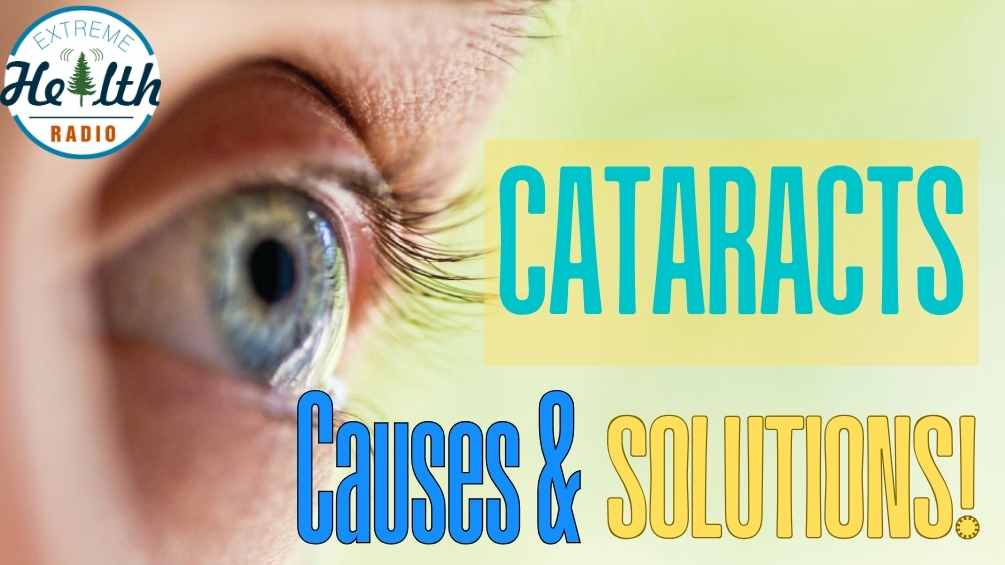
Despite what your ophthalmologist has told you, there are many natural remedies to cure cataracts that they don’t know about.
Apparently they don’t know how to read research papers.
The mainstream medical approach to curing cataracts is to remove the lens of your eye and replace it with a new one. This is bonkers because they treat the human body like a car or machine. Just remove old parts and put new ones in, is their approach.
The human body is not a machine and you can’t just put in parts that do not contain our DNA and expect it to work, especially in the long term.
The medical industrial complex gives zero lip service to what causes cataracts and how can they be prevented. If they did, they’d lose billions of dollars (roughly 13 to 26 billion) per year in cataracts surgery. It’s more lucrative to them to let you keep getting a chronic disease only so that they can perform a surgery on you that makes them thousands of dollars.
How about we change all that?
How about we understand the cause of cataracts so that we can slow its progression? How about we then take targeted supplementation to nourish our eyes to restore our vision?
It’s time we take full responsibility of our health so that we can experience the kind of life we want outside of the medical industrial complex.
Remember, curing you is bad for business. 🙁
Understanding Cataracts
Remember, knowledge is power. The more you understand how the body works, the more you’re able to take care of it yourself without having to rely on a doctor who doesn’t do their research.
What Are Cataracts?
Cataracts happen when the lens of your eye gets cloudy, and it appears from my research that the leading causes are oxidative stress, poor nutrition, and high blood sugar. Too much sun exposure (this means staring at the sun), smoking, and even certain meds (like steroids and statins) can speed up the damage to your vision, making it worse over time. If you’re loading up on processed foods like sugars and carbohydrates, skipping your greens, and ignoring your eye health, you’re basically rolling out the red carpet for cataracts to show up sooner than they should.
Types of Cataracts
It’s interesting because as humans we like to put names to conditions and then treat those names with medications. The human body doesn’t work that way. So keep that in mind. There is only one disease, a lack of adequate ATP production at the mitochondrial levels.
If your body can make enough energy there is no disease. Plain and simple.
But with that said here’s how the conventional medical doctors will break down cataracts…
- Age-related cataracts (most common, due to aging).
- Diabetic cataracts (linked to high blood sugar and oxidative stress).
- Congenital cataracts (present at birth or childhood).
- Secondary cataracts (caused by medications, UV radiation, toxins).
- Traumatic cataracts (resulting from eye injuries).
Causes & Risk Factors
In this section I’m going to go over the common causes and risk factors for cataracts.
The causes I’m going to share below, are all spokes in the wheel of making ATP (energy). Remember, energy is the currency of the body. When your body cannot create enough energy to deal with the toxins, chemicals and other assaults to our health that’s when symptoms show up.
There are two main ways to help with improving vision and getting rid of cataracts naturally.
- Improve ATP production
- Eliminate everything that prevents ATP production
Those are two tall orders but they can be done.
Notice in the list below that all 7 of the items below inhibit mitochondrial ATP production.
- Oxidative stress & free radicals (damage lens proteins and lipids).
- Nutrient deficiencies (lack of antioxidants like Vitamin C, Vitamin E, lutein, zeaxanthin).
- Diabetes & high blood sugar (leads to sorbitol accumulation in the lens).
- High carbohydrate diet (processed foods contribute to cataract formation).
- UV radiation exposure (photo-oxidation of lens proteins).
- Smoking & alcohol consumption (increase oxidative stress).
- Medications (statins, corticosteroids, tamoxifen linked to cataracts).
Natural Remedies to Prevent and Reverse Cataracts
Nutritional Remedies
The name of the game when it comes to vision health is having clean oxygen rich blood, healthy blood vessels to transport that blood and lots of antioxidants. What good is it to have lots of antioxidants if your blood is too viscous and polluted. I recommend (for myself because I cannot give medical advice to you) regular blood donations (to reduce blood viscosity) along with nutrients that help restore the structural integrity of blood vessels and veins. The benefits of giving blood are almost too many to count. I highly recommend it.
Those would be silica, sulfur, vitamin C, copper and gelatin.
Now that your blood is less thick and you’ve improved the stretch and elasticity of your blood vessels, now it’s time to introduce an antioxidant rich diet and supplement plan.
A quick note on absorption, if you are over the age of 50 I would recommend increasing your HCL intake to be able to absorb all the nutrients mentioned in this article. Dr. Mary VanSant of the Mayo Clinic did a study of 3,400 people back in 1931 and over half of them were not creating enough hydrochloric acid to digest their food.
This was back in 1931 when most people were eating organic food from farms and were not exposed to Wi-Fi and blue light. In her study, the age at which people were not producing enough HCL was 60. I lowered the age for 50 to compensate for today’s modern toxic lifestyle and environment.
Antioxidant-rich diet
- Vitamin C (found in citrus fruits, bell peppers, leafy greens) helps prevent oxidation of lens proteins.
- Vitamin E (nuts, seeds, spinach) protects against oxidative damage.
- Lutein & Zeaxanthin (spinach, kale, broccoli) filter harmful blue light and reduce cataract risk.
- Quercetin (onions, apples, berries) inhibits enzymes that contribute to cataract formation.
- Resveratrol (red grapes, blueberries) supports eye health.
Herbal & Plant-Based Remedies
Herbs and plant medicines have been used for thousands of years to help people recover from sickness. I consider plants to be medicines and food comes from animals. If you neglect one over the other, you do so at your own peril.
Here are some herbs that have been traditionally used as natural remedies to cure cataracts.
- Amla (Indian gooseberry) – Contains antioxidants that delay cataract development.
- Bilberry – Rich in anthocyanins, shown to improve vision and slow cataract progression.
- Curcumin (from turmeric) – Anti-inflammatory properties protect eye tissue.
- Fenugreek – Traditionally used for eye health in Ayurveda.
Lifestyle Modifications
This is probably the hardest to follow for most people. It’s easy to take a few supplements. It’s easy to follow a diet but it’s not as easy for folks to start working out or lower stress. But if you want to live a long healthy disease free life I highly encourage you to make changes to your life that reduces overall stress levels.
That could mean changing jobs, breaking up a relationship or moving out of your home. It’s different for each person but your health depends on it.
Protect Your Eyes from filtered Light
- Avoid wearing sunglasses that block UVA/UVB rays.
- Avoid staring at the sun or directly into the sun.
Regular Exercise & Stress Management
- Reduces inflammation and supports overall eye health.
- Yoga, meditation, and deep breathing improve circulation.
Avoid Harmful Substances
- Reduce alcohol and quit smoking.
- Minimize exposure to environmental toxins.
Supplements & Alternative Therapies
- Acetyl-l-carnitine – Found to have anti-cataract properties.
- Hydrogen water therapy – Antioxidant-rich water may reduce oxidative stress.
- DMSO eye drops – Emerging research suggests some may help dissolve cataracts.
Scientific Studies Supporting Natural Cataract Treatments
What people don’t realize is that the current medical industrial complex is the real alternative medicine. Natural medicine is how we got here. People throughout history have been using nature based principles to allow humans to exist until now.
Our medical system is what I like to call Rockefeller Medicine. It’s new, it’s synthetic, and it’s not found in nature.
As a result it is highly toxic. Yes sometimes it works but it’s very dangerous.
Water Soluble Vitamins in the Ocular and Cardiac Diseases
I’ve been taking Vitamin C for some time. I’m noticing my mom whose eyes have macular degeneration and this is caused by oxidized fats in the back of the eye where the macula is. Vitamin C dramatically lowers oxidative stress in all tissues of the body, especially the eye.
A study titled Water Soluble Vitamins in the Ocular and Cardiac Diseases was conducted in 2024 and examined the effects of Vitamin C on cataract development. The observational study analyzed over 490 mg of daily Vitamin C intake in a large human cohort over several years and found that individuals with higher Vitamin C intake had a 33% lower risk of cataracts. The study concluded that Vitamin C plays a significant role in protecting against oxidative stress in the eye, reducing the likelihood of cataract formation. Source
Molecular Mechanisms of Vitamin E in Ocular Neurodegenerative Disorders
The research I’ve read shows that vitamin E works together with Vitamin C to donate electrons to lower oxidative stress. The great thing I love about vitamin E is that it is one of the few fat soluble vitamins. They are Vitamin A, Vitamin E, Vitamin D and Vitamin K. I find it easier to remember A, E, D and K.
A 2025 study, Molecular Mechanisms of Vitamin E in Ocular Neurodegenerative Disorders, explored the impact of Vitamin E on cataract prevention. The study followed 161,947 individuals for multiple years and found that Vitamin E intake was linked to an 8.05% reduction in cortical cataract risk. Researchers concluded that Vitamin E’s antioxidant properties help protect the lens from oxidative damage, potentially slowing cataract progression. Source
The Aging Eye and the Role of L-Carnitine and Its Derivatives
I’m a huge fan of L-Carnitine and how it can be used in the body to lower oxidative stress. The study below is just one example. Remember, oxidative stress (think of a piece of metal sitting outside in your backyard rusting) is what brings down all humans. If it’s lowering oxidative stress, it’s also slowing the aging process.
Although most research on Acetyl-L-Carnitine and cataracts has been conducted in animals, a review titled The Aging Eye and the Role of L-Carnitine and Its Derivatives suggests its potential benefits for human cataract prevention. Conducted in 2008, this study reviewed prior human trials and found evidence that Acetyl-L-Carnitine supports lens health by reducing oxidative damage and maintaining mitochondrial function. The conclusion indicated that further human clinical trials are needed to establish its role in cataract prevention. Source
Eye Health: Macular Degeneration, Cataracts, Diabetic Retinopathy
Bilberry is always high on my list for improving vision and maintaining eye health.
Bilberry’s effects on cataracts were investigated in a 2020 study, Eye Health: Macular Degeneration, Cataracts, Diabetic Retinopathy, which examined anthocyanin-rich supplements in a group of individuals with early-stage cataracts. Over a six-month period, subjects taking bilberry and pine bark extract showed improved visual acuity and reduced lens opacity compared to a control group. The study concluded that bilberry’s antioxidants might help slow cataract progression, but further studies are necessary. Source
Protective Role and Enhanced Intracellular Uptake of Curcumin in Retinal Cells
Remember, make animals your food and plants your medicine. Do this and you’ll maintain great vision all the days of your life. Here’s a really interesting study about using curcumin to improve vision.
A 2025 study titled Protective Role and Enhanced Intracellular Uptake of Curcumin in Retinal Cells explored the effects of antioxidants on cataracts and other eye disorders. This research, which included both human and in-vitro studies, demonstrated that increased antioxidant intake, particularly from plant-based sources, helped reduce cataract development by combating oxidative stress in the eye. The study concluded that antioxidants play a protective role in maintaining lens clarity and delaying age-related cataracts. Source
Conclusion:
A Holistic Approach to Cataract Prevention & Reversal
As you can see we’ve barely scratched the surface with natural remedies to cure cataracts. There are many and they all work on different levels to varying degrees by targeting different metabolic pathways. But the concept is simple, stop doing whatever is causing your brain to tell the eyes to make cataracts. Those things could be a lot so I’ll list them below.
Then, once you stop participating in the cause (like banging your head against the wall) then you can start taking the natural remedies to cure your cataracts. It’s a one/two approach that could take up to a year but it will work.
Here’s what I’d do to cure cataracts if I had them….
- Wear blue blocking glasses for both day and night
- Install Iris Tech
- Use red lights in my home or office if possible
- Get outside often without sunglasses and contact lenses (don’t look at the sun though)
- Avoid processed foods and carbohydrates that lead to diabetes and cataracts
- Take vitamin c, vitamin e, curcumin and bilberry
- Follow the remaining steps outlined in My Vision Protocol
Questions
- Does cataracts run in your family?
- How about diabetes?
- What natural cures have you tried? Did they work?
Comment below!


